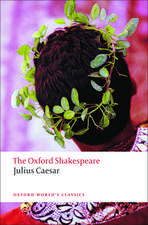The Merchant of Venice: Dover Thrift Editions
Autor William Shakespeareen Limba Engleză Paperback – 31 mai 1995 – vârsta de la 14 ani
In this richly plotted drama, Shylock, whom Shakespeare endowed with all of the depth and vitality of his greatest characters, is not alone in his villainy. In scene after scene, a large cast of ambitious and scheming characters demonstrates that honesty is a quality often strained where matters of love and money are concerned.
The gravity and suspense of the play's central plot, together with its romance, have made "The Merchant of Venice" a favorite of audiences, and one of the most studied and performed of Shakespeare's plays. It is reprinted here from an authoritative text, complete with explanatory footnotes."
Din seria Dover Thrift Editions
-
 Preț: 39.39 lei
Preț: 39.39 lei -
 Preț: 67.45 lei
Preț: 67.45 lei -
 Preț: 25.15 lei
Preț: 25.15 lei -
 Preț: 52.41 lei
Preț: 52.41 lei -
 Preț: 25.77 lei
Preț: 25.77 lei - 36%
 Preț: 61.44 lei
Preț: 61.44 lei - 16%
 Preț: 21.50 lei
Preț: 21.50 lei -
 Preț: 43.52 lei
Preț: 43.52 lei - 16%
 Preț: 21.16 lei
Preț: 21.16 lei -
 Preț: 33.19 lei
Preț: 33.19 lei - 16%
 Preț: 66.56 lei
Preț: 66.56 lei -
 Preț: 34.65 lei
Preț: 34.65 lei - 17%
 Preț: 31.67 lei
Preț: 31.67 lei -
 Preț: 55.06 lei
Preț: 55.06 lei -
 Preț: 29.49 lei
Preț: 29.49 lei -
 Preț: 49.32 lei
Preț: 49.32 lei -
 Preț: 40.20 lei
Preț: 40.20 lei -
 Preț: 40.44 lei
Preț: 40.44 lei - 17%
 Preț: 18.21 lei
Preț: 18.21 lei - 55%
 Preț: 16.97 lei
Preț: 16.97 lei -
 Preț: 37.31 lei
Preț: 37.31 lei - 20%
 Preț: 16.43 lei
Preț: 16.43 lei - 16%
 Preț: 53.42 lei
Preț: 53.42 lei -
 Preț: 32.78 lei
Preț: 32.78 lei - 14%
 Preț: 27.66 lei
Preț: 27.66 lei - 17%
 Preț: 31.13 lei
Preț: 31.13 lei - 48%
 Preț: 16.17 lei
Preț: 16.17 lei -
 Preț: 56.50 lei
Preț: 56.50 lei -
 Preț: 30.53 lei
Preț: 30.53 lei -
 Preț: 38.35 lei
Preț: 38.35 lei - 15%
 Preț: 40.71 lei
Preț: 40.71 lei - 13%
 Preț: 28.46 lei
Preț: 28.46 lei -
 Preț: 76.91 lei
Preț: 76.91 lei -
 Preț: 83.12 lei
Preț: 83.12 lei -
 Preț: 27.45 lei
Preț: 27.45 lei - 13%
 Preț: 34.43 lei
Preț: 34.43 lei -
 Preț: 170.50 lei
Preț: 170.50 lei -
 Preț: 44.94 lei
Preț: 44.94 lei -
 Preț: 30.53 lei
Preț: 30.53 lei -
 Preț: 39.62 lei
Preț: 39.62 lei -
 Preț: 26.81 lei
Preț: 26.81 lei -
 Preț: 27.45 lei
Preț: 27.45 lei -
 Preț: 34.87 lei
Preț: 34.87 lei -
 Preț: 32.03 lei
Preț: 32.03 lei - 17%
 Preț: 18.15 lei
Preț: 18.15 lei -
 Preț: 28.44 lei
Preț: 28.44 lei -
 Preț: 56.93 lei
Preț: 56.93 lei - 17%
 Preț: 20.71 lei
Preț: 20.71 lei -
 Preț: 25.35 lei
Preț: 25.35 lei - 16%
 Preț: 66.10 lei
Preț: 66.10 lei
Preț: 21.06 lei
Preț vechi: 27.06 lei
-22% Nou
Puncte Express: 32
Preț estimativ în valută:
4.03€ • 4.19$ • 3.33£
4.03€ • 4.19$ • 3.33£
Carte disponibilă
Livrare economică 24-31 martie
Preluare comenzi: 021 569.72.76
Specificații
ISBN-13: 9780486284927
ISBN-10: 0486284921
Pagini: 96
Dimensiuni: 133 x 210 x 7 mm
Greutate: 0.08 kg
Editura: Dover Publications
Seria Dover Thrift Editions
ISBN-10: 0486284921
Pagini: 96
Dimensiuni: 133 x 210 x 7 mm
Greutate: 0.08 kg
Editura: Dover Publications
Seria Dover Thrift Editions
Descriere
The Merchant of Venice has been performed more often than any other comedy by Shakespeare. This edition pays special attention to the expectations of its first audience, and to our modern experience of seeing and hearing the play. Mahood explores
Textul de pe ultima copertă
Great pains have been taken to follow Shakespeare's intentions with regard to the act and scene division and the exact form of speech. The editing has been done from the quarto or folio texts, depending on which considered more authoritative, and the ideal has been to reproduce the chosen texts with as few alterations as possible. In order to help the reader and student, the annotations have been arranged on the relevant pages, providing an easily accessible and indispensable source of information.
Notă biografică
William Shakespeare was born in Stratford-upon-Avon in April 1564, and his birth is traditionally celebrated on April 23. The facts of his life, known from surviving documents, are sparse. He was one of eight children born to John Shakespeare, a merchant of some standing in his community. William probably went to the King’s New School in Stratford, but he had no university education. In November 1582, at the age of eighteen, he married Anne Hathaway, eight years his senior, who was pregnant with their first child, Susanna. She was born on May 26, 1583. Twins, a boy, Hamnet ( who would die at age eleven), and a girl, Judith, were born in 1585. By 1592 Shakespeare had gone to London working as an actor and already known as a playwright. A rival dramatist, Robert Greene, referred to him as “an upstart crow, beautified with our feathers.” Shakespeare became a principal shareholder and playwright of the successful acting troupe, the Lord Chamberlain’s Men (later under James I, called the King’ s Men). In 1599 the Lord Chamberlain’s Men built and occupied the Globe Theater in Southwark near the Thames River. Here many of Shakespeare’s plays were performed by the most famous actors of his time, including Richard Burbage, Will Kempe, and Robert Armin. In addition to his 37 plays, Shakespeare had a hand in others, including Sir Thomas More and The Two Noble Kinsmen, and he wrote poems, including Venus and Adonis and The Rape of Lucrece. His 154 sonnets were published, probably without his authorization, in 1609. In 1611 or 1612 he gave up his lodgings in London and devoted more and more time to retirement in Stratford, though he continued writing such plays as The Tempest and Henry VII until about 1613. He died on April 23 1616, and was buried in Holy Trinity Church, Stratford. No collected edition of his plays was published during his life-time, but in 1623 two members of his acting company, John Heminges and Henry Condell, put together the great collection now called the First Folio.
Recenzii
Ken Rothwell does a splendid updating of Kittredge's Merchant of Venice with considerations of the play in performance. His essay on the play's stage history is lucid, his additions to Kittredge's notes are indicative of performance choices, and, as one would expect of the preeminent scholar of Shakespeare on film, his discussion of cinematic adaptations of Merchant is richly informative. This edition should prove useful to all levels of undergraduates. - James Bulman, Allegheny College
Even as the New Kittredge Shakespeare series glances back to George Lyman Kittredge's student editions of the plays, it is very much of our current moment: the slim editions are targeted largely at high school and first-year college students who are more versed in visual than in print culture. Not only are the texts of the plays accompanied by photographs or stills from various stage and cinema performances: the editorial contributions are performance-oriented, offering surveys of contemporary film interpretations, essays on the plays as performance pieces, and an annotated filmography. Traditional editorial issues (competing versions of the text, cruxes, editorial emendation history) are for the most part excluded; the editions focus instead on clarifying the text with an eye to performing it. There is no disputing the pedagogic usefulness of the New Kittredge Shakespeare's performance-oriented approach. At times, however, it can run the risk of treating textual issues as impediments, rather than partners, to issues of performance. This is particularly the case with a textually vexed play such as Pericles: Prince of Tyre . In the introduction to the latter, Jeffrey Kahan notes the frequent unintelligibility of the play as originally published: "the chances of a reconstructed text matching what Shakespeare actually wrote are about 'nil'" (p. xiii) But his solution to use a "traditional text" rather than one corrected as are the Oxford and Norton Pericles obscures how this "traditional text," including its act and scene division, is itself a palimpsest produced through three centuries of editorial intervention. Nevertheless, the series does a service to its target audience with its emphasis on performance and dramaturgy. Kahan's own essay about his experiences as dramaturge for a college production of Pericles is very good indeed, particularly on the play's inability to purge the trace of incestuous desire that Pericles first encounters in Antioch. Other plays' cinematic histories: Annalisa Castaldo's edition of Henry V contrasts Laurence Oliver's and Branagh's film productions; Samuel Crowl's and James Wells's edition of (respectively) I and 2 Henry IV concentrate on Welle's Chimes at Midnight and Gus Van Sant's My Own Private Idaho ; Patricia Lennox's edition of As You Like It offers an overview of four Hollywood and British film adaptations; and John R. Ford's edition of A Midsummer Night's Dream provides a spirited survey of the play
Even as the New Kittredge Shakespeare series glances back to George Lyman Kittredge's student editions of the plays, it is very much of our current moment: the slim editions are targeted largely at high school and first-year college students who are more versed in visual than in print culture. Not only are the texts of the plays accompanied by photographs or stills from various stage and cinema performances: the editorial contributions are performance-oriented, offering surveys of contemporary film interpretations, essays on the plays as performance pieces, and an annotated filmography. Traditional editorial issues (competing versions of the text, cruxes, editorial emendation history) are for the most part excluded; the editions focus instead on clarifying the text with an eye to performing it. There is no disputing the pedagogic usefulness of the New Kittredge Shakespeare's performance-oriented approach. At times, however, it can run the risk of treating textual issues as impediments, rather than partners, to issues of performance. This is particularly the case with a textually vexed play such as Pericles: Prince of Tyre . In the introduction to the latter, Jeffrey Kahan notes the frequent unintelligibility of the play as originally published: "the chances of a reconstructed text matching what Shakespeare actually wrote are about 'nil'" (p. xiii) But his solution to use a "traditional text" rather than one corrected as are the Oxford and Norton Pericles obscures how this "traditional text," including its act and scene division, is itself a palimpsest produced through three centuries of editorial intervention. Nevertheless, the series does a service to its target audience with its emphasis on performance and dramaturgy. Kahan's own essay about his experiences as dramaturge for a college production of Pericles is very good indeed, particularly on the play's inability to purge the trace of incestuous desire that Pericles first encounters in Antioch. Other plays' cinematic histories: Annalisa Castaldo's edition of Henry V contrasts Laurence Oliver's and Branagh's film productions; Samuel Crowl's and James Wells's edition of (respectively) I and 2 Henry IV concentrate on Welle's Chimes at Midnight and Gus Van Sant's My Own Private Idaho ; Patricia Lennox's edition of As You Like It offers an overview of four Hollywood and British film adaptations; and John R. Ford's edition of A Midsummer Night's Dream provides a spirited survey of the play
Cuprins
Shakespeare's life; Elizabethan world view; The Globe Theatre; Introduction to The Merchant of Venice; The setting of the play; The Jews; Usury; The major themes: 1. The 'bond', justice and mercy; 2. Appearance versus reality; 3. Change or destiny versus choice; 4. The 'Ring' theme; 5. Commercial or material values versus love.
Caracteristici
Comprehensive, illustrated Introduction gives full critical and stage histories of the play and opens up new readings






















